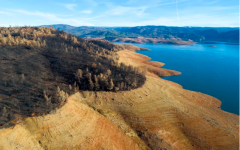
State Water Project Lake Oroville. (Photo: water.ca.gov)
California Increasing State Water Release from 0% to 15% of Requested, Following Winter Storms
‘The state has been taking water away from farms and from people for too long now’
By Evan Symon, January 20, 2022 4:02 pm
The Department of Water Resources (DWR) announced on Thursday that they would be releasing more stored water through the State Water Project, due to several weeks of wet weather, increasing the allocation from 0% to 15%.
In early December, the DWR set the initial 2022 State Water Project allocation at 0% for the first time in project history. The decision by the State Water Project, which is one water source out of several for 29 districts that covers 27 million residents and 750,000 acres of farmland in California through a system of dams, reservoirs, and canals, set many areas of the state into a panic due to their reliance on Water Project water.
The decision was spurred by the ongoing drought, with factors including higher temperatures, a reduced snowpack in the Sierra Nevada mountains, lower precipitation levels, and the state releasing large amounts of water solely for environmental reasons.
However, shortly after the DWR announcement, numerous winter storms occurred throughout California for most of December and early January. Record snow and rain amounts fell in numerous parts of the state, including the most snow to fall in Lake Tahoe since 1960. While the drought is still in effect for California, along with ongoing water reduction measures, the rain/precipitation from the winter storms brought California out of the worst drought category, pushed snowpack amounts to 160%, caused reservoir levels to rise, and even naturally brought back coho salmon populations without help from the state.
As a result, DWR officials announced that water agencies will now be getting 15% of their requested amount of water instead of the initial announcement of 0%. However, officials noted that drought conditions persist, and more precipitation is needed to normalize water amounts and to refill state reservoirs such as their largest, Lake Oroville.
“December storms enabled DWR to convey and store water in San Luis Reservoir, which allows for a modest increase in water deliveries this year,” said DWR Director Karla Nemeth on Thursday. “But severe drought is not over. Dry conditions have already returned in January. Californians must continue to conserve as the state plans for a third dry year.”
“The next two months are traditionally the heart of California’s rainy season. We need more storms to keep filling up our reservoirs to make up for two critically dry years.”
With mandatory water restrictions now underway, and more restrictions likely throughout the year if weather remains dry, water experts stressed that while permanent changes were needed to how water is used in the state, it should not come to as a cost to agriculture or urban usage.
“The DWR needs to focus again on people,” said water engineer Shane Alexander, who has worked on numerous water projects in California and with other Western states currently affected by the drought, to the Globe on Thursday. “The environment, you know, great. Wild animals deserve it too. It’s nature. But the state has been taking water away from farms and from people for too long now. And look. Farms are failing, smaller towns aren’t getting as much. Agriculture is a huge part of California, not just in terms of the economy but also in keeping the nation fed, especially during the winter. And as for keeping water flowing to urban areas, well, California wants to stop the number of people leaving the state. There are many reasons for it, I don’t want to get into it. But, if the state doesn’t have to say ‘We’re low on water’ or ‘We’re running out of water,’ then that’s a good basic need to have down as a building block to attract people.”
“The state hasn’t been looking at water the right way for some time now. Bringing back some water, while I’m not convinced they’ve changed their ways, it’s a good step. If there is anything Californians can agree on, it’s that we need more rain. Not flood amounts or enough to cause landslides. But enough to bring us back.”
A final State Water Project allocation amount will determined by May or June, dependent on how much more precipitation falls between now and then.
- Bill to Require Law Enforcement Disclosure if AI Was Used To Help Write Reports - August 7, 2025
- Gov. Newsom Files FOIA Request To ‘Expose True Cost’ Of L.A. Federal Troop Deployment for Anti-ICE Riots - August 6, 2025
- California Redistricting: How Newsom’s Plan Will Demolish Hard Fought GOP Gains - August 6, 2025





One thought on “California Increasing State Water Release from 0% to 15% of Requested, Following Winter Storms”